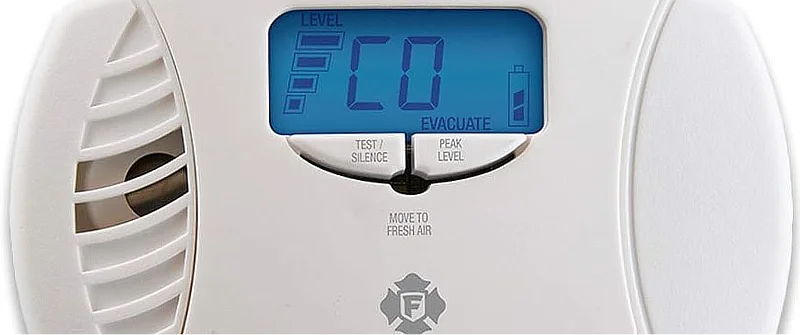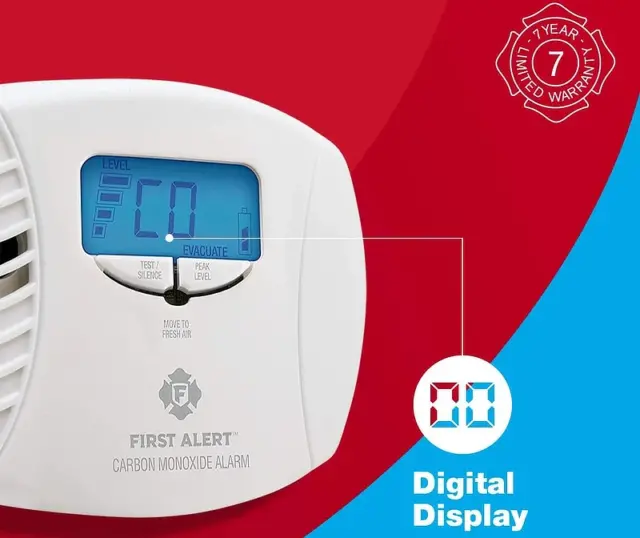Carbon Monoxide Poisoning Symptoms and Prevention

Carbon Monoxide is Poisonous, Odorless, Silent, Colorless, and Tasteless. Carbon monoxide poisoning symptoms and the onset of noticeable affects are also shared with other causes. The problem here is that this one can lead to death.
Here’s that part where I try and scare you into action:
Carbon Monoxide Poisoning may be occurring Right Now and you may not know it until it’s too late – possibly while you are sleeping.
Do you have a Wood Stove? Pellet Stove? Oil, Natural Gas, or LP Propane heating system?
If the combustion or venting is inadequate, leaking, or of poor quality, you could be experiencing Carbon Monoxide poisoning.
Here’s what you need to know!
Get yourself a Carbon Monoxide Detector!
My goodness, how much are the lives worth in your household? At least ~ $30, right?
Before I get into the rest of the article including carbon monoxide symptoms, how it happens, and the levels which are considered dangerous.. This is the brand / model carbon monoxide detector that I use here at home. I consider it to be one of the best for household use:
First Alert CO615
(amzn)

I like it because of the automatic battery backup, and the fact that you can see the actual carbon monoxide level numbers in PPM (parts per million). But please, just pick one of the many CO detectors that are available and get it plugged in at home.
How Does Carbon Monoxide Poisoning Happen?
Carbon Monoxide (CO) is produced whenever a combustible fuel is burned.
The amount produced depends on the fuel and the quality of the burn or combustion. A poor burn or improper ventilation will build up a high concentration of Carbon Monoxide in the home.
You can’t smell it, so you won’t know that it’s happening.
I have a pellet stove. The firebox is a sealed system that draws fresh air in from the outside and expels the heated firebox air back outside up the flu. While carbon monoxide is produced in the burn to some extent, it never gets into the house.
However, don’t let that be an excuse. You should still have a carbon monoxide detector in case there’s a leak..
Do you have a wood stove? Same thing applies. It also applies to any furnace too.
Symptoms of Carbon Monoxide Poisoning
Carbon Monoxide in high concentrations, starves the oxygen from bodily tissues.
This could lead to seizure, coma, and fatality.
Preliminary Symptoms
Flu-like
Headache
Nausea
Dizziness
Fatigue
Weakness
Muscle aches
Shortness of breath
How Many People Die of Carbon Monoxide Poisoning or Treated Each Year?
In the United States, more than 400 people die each year from accidental Carbon Monoxide poisoning.
Thousands of people each year require emergency treatment.
Dangerous Levels ( PPM ) ?
(parts per million)
It only takes a minuscule amount to harm or kill you.
100 ppm (parts per million) can result in Carbon Monoxide poisoning and give you a headache after 1-2 hours.
400 ppm can be life threatening after 3 hours.
How is Carbon Monoxide Deadly?
Hemoglobin in the blood carries oxygen from the lung to our organs. But it has an affinity for Carbon Monoxide that is 200 times its affinity for oxygen!
So CO gets grabbed up first and oxygen gets pushed aside. CO stays attached to the hemoglobin for hours, so as it is taken up it begins to saturate the blood.
Eventually NO OXYGEN can be taken up and transported to the cells of our organs, and they begin to die.
Will Carbon Monoxide Accumulate Downstairs or Upstairs?
Carbon Monoxide is a gas that weighs slightly less than air.
It will tend to rise and accumulate more upstairs in a home if the heating system is malfunctioning.
However, the first floor is still vulnerable under the same circumstances!
New Construction Modern ‘Tight’ Homes
Back in the “Old Days” the houses were not constructed as ‘tight’ as they are today. Basically, they leaked air a lot, which is why old houses took so much energy to heat.
In most old houses, more than half of the heat loss was from cold air leaking in! Carbon Monoxide could not build up as quickly inside.
With newer ‘tight’ construction, less infiltration (leakage) means that gases can build up inside, and Carbon Monoxide can concentrate if a source is there.
How To Prevent Carbon Monoxide Poisoning
A furnace that is not completely and efficiently burning all of its fuel (poor combustion) will produce excess Carbon Monoxide. Regular service is advised.
Furnaces with air-intake filters can clog, causing poor fuel combustion and high Carbon Monoxide levels. Periodically check the air intake.
Furnaces with improper venting (including wood stoves) will release high amounts of Carbon Monoxide into the living area.
Prevention is the key to survival.
Preventing Carbon Monoxide poisoning is a three step process.
1. Proper Venting
2. Ensure Good Combustion
3. Carbon Monoxide Detector
Detection can only be trusted to a quality Carbon Monoxide detector. Every home should have at least one. Best to have one on each level of the home.
Particularly during the winter months, please consider protecting your family from the unthinkable. Just like a home smoke alarm, a Carbon Monoxide detector could save your life!
[ Read: Dual Sensor Smoke Alarm – Why They Are The Best ]
Best Place To Mount Carbon Monoxide Detector
A likely place to be caught off guard for Carbon Monoxide poisoning is while you’re sleeping in the bedroom. Keep one within earshot of where you sleep.
One on each floor of your home
Most Carbon Monoxide detectors simply plug into a wall outlet (with a built-in battery backup). So don’t worry about high up on a wall or lower to the floor. Most outlets are near the floor. That’s good enough. Just have one!
Shelf Life? Do Carbon Monoxide Detectors Expire?
IMPORTANT: Carbon Monoxide detectors (and smoke detectors) do have a limited shelf life! This varies between 5 and 10 years depending on the manufacturer. Many will have a date on the back or inside (the battery compartment).
[ Read: Caution: Smoke Detectors Have A Shelf Life ]
I remember last year when my Carbon Monoxide detector let out a loud chirp, and then later on again… I checked to discover that it was six years old (end of shelf life?). There was no indication on the digital screen of a any detected Carbon Monoxide level (ppm was ‘000’), so I figured that it was flaking out due to its age. So I ordered two of the latest replacements.
This is important folks. If you don’t have one of these, you should consider it:
One of the most popular and best reviewed on Amazon:
First Alert CO Detector
